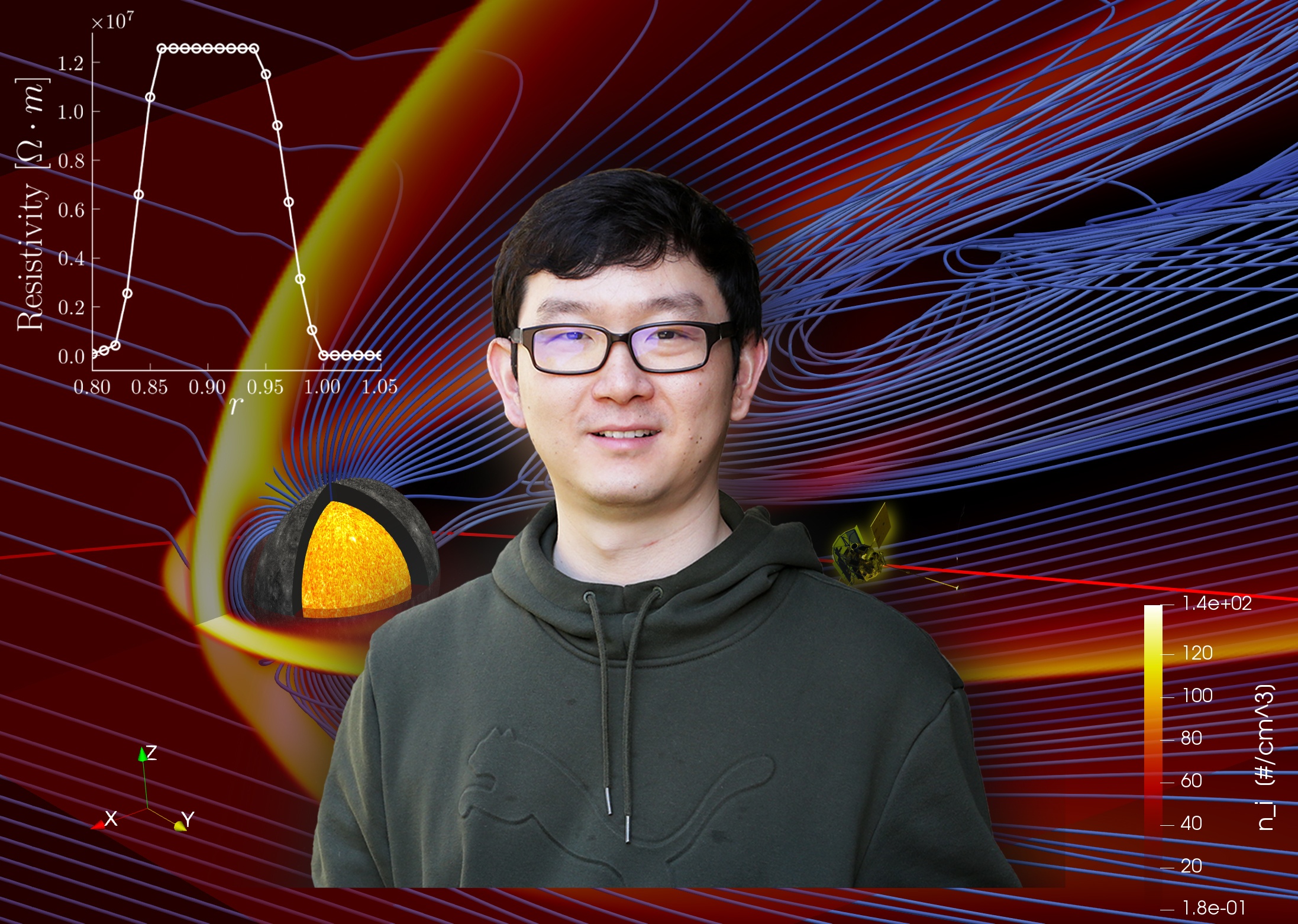Mercury, the planet nearest the sun, shares with Earth the distinction of being one of the two mountainous planets in the solar system with a global magnetic field that shields it from cosmic rays and the solar wind. Now researchers, led by physicist Chuanfei Dong of the Princeton University Center for Heliophysics and the U.S. Department of Energy’s (DOE) Princeton Plasma Physics Laboratory (PPPL), have developed the first detailed model of the interaction between the magnetized wind and the magnetic field, or magnetosphere, that surrounds the planet — findings that could lead to improved understanding of the stronger field around Earth.
Basic tool
Dong used a new three-dimensional simulation code called “Gkeyll” that incorporates the physics of micro-scale behavior in a sophisticated macroscale model. The simulation will deliver a basic tool to the twin-satellite BepiColombo mission en route to Mercury, for which Dong is a co-investigator of a suite of four instruments on board the spacecraft. The international mission, named for the late mathematician Giuseppe (Bepi) Colombo of the University of Padua and launched by European and Japanese space agencies in 2018, is scheduled to reach Mercury and begin orbiting in 2025. “We will supply numerical information based on the model that will help the mission understand its findings,” said Dong, lead author of a paper describing the model in Geophysical Research Letters.
Plasma, the state of matter that consists of positively charged atomic nuclei and negatively charged electrons, makes up 99 percent of the visible universe. Magnetic reconnection, the merging and violent separation of the magnetic field lines in plasma, regulates the Mercury magnetosphere, which is much smaller but far more dynamic than Earth’s. Reconnection occurs when the solar wind strikes the Mercury magnetosphere, causing its magnetic field to cycle from the front, or dayside, of the magnetosphere to the rear, or nightside, where reconnection reoccurs and the field cycles back to dayside.
The research team captured the physics of this process by simulating an unprecedented 10 distinct variables with Gkeyll. The model captures important aspects of the motion of the electrons near the reconnection site, an important but little- understood aspect of the process, and agrees well with observations of the NASA Mercury Surface, Space Environment, Geochemistry and Ranging (MESSENGER) satellite that orbited Mercury from 2011 to 2015.
Both sides now
While the single-satellite MESSENGER could not collect data from the day- and night- side fields of Mercury simultaneously, the twin-satellite BepiColombo mission will explore both sides of the magnetosphere. In addition, since MESSENGER’s periapsis, or path closest to Mercury, was in the northern hemisphere, the southern hemisphere and its magnetic field have not yet been fully investigated. The BepiColombo mission will cover both hemispheres.
A peculiarity of Mercury is that its magnetic field is some three times stronger in the northern hemisphere than in the southern, contrary to Earth’s, where the fields are basically the same. Generating the fields in both planets is the shifting liquid iron in their electrically conducting molten cores. In Mercury the unusually large core extends over 80 percent of the radius of the interior, tightly coupling the field to the core that creates it.
The new model enabled Dong and his team to explore many key features of the Mercury magnetosphere, such as reconnection in the boundary between the solar wind and the magnetic field and the back-and-forth cycling of the field. The model uncovered the essential role of electron physics in the reconnection process, which is “collisionless” because the widely separated plasma particles in space don’t often collide. The model further revealed that the tight coupling between the magnetosphere and the large iron core helps to protect Mercury from erosion by the solar wind.
Crucial step
These findings, said Dong, “represent a crucial step toward establishing an innovative revolutionary approach” to improved understanding of the physics behind the contact of the solar wind with the lopsided magnetosphere of the planet closest to the sun. “Chuanfei’s work is a valuable milestone in validating our effort to model space weather in planets, and sets up for making predictions on both low-intensity and extreme space weather events on Earth,” said Amitava Bhattacharjee, director of the Princeton Center for Heliophysics and a coauthor of the paper.
The full list of coauthors includes researchers from PPPL, the Princeton Center for Heliophysics, the University of Michigan, the University of New Hampshire and the NASA Goddard Space Flight Center. Support for this work comes from the U.S. Department of Energy Office of Science, the National Science Foundation and NASA.
PPPL, on Princeton University’s Forrestal Campus in Plainsboro, N.J., is devoted to creating new knowledge about the physics of plasmas — ultra-hot, charged gases — and to developing practical solutions for the creation of fusion energy. The Laboratory is managed by the University for the U.S. Department of Energy’s Office of Science, which is the single largest supporter of basic research in the physical sciences in the United States and is working to address some of the most pressing challenges of our time. For more information, visit energy.gov/science.
Original post https://alertarticles.info
